
The Grumman F7F Tigercat is a heavy fighter aircraft that served with the United States Navy (USN) and United States Marine Corps (USMC) from late in World War II until 1954. It was the first twin-engine fighter to be deployed by the USN. While the Tigercat was delivered too late to see combat in World War II, it did serve in reconnaissance roles. The Tigercat primarily saw action as a night fighter and attack aircraft during the Korean War.
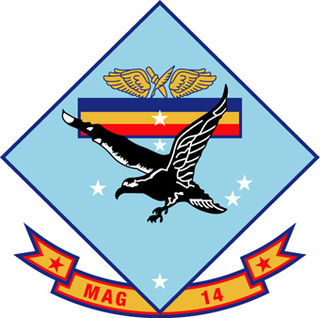
Marine Aircraft Group 14 (MAG-14) is a United States Marine Corps aviation unit based at Marine Corps Air Station Cherry Point, North Carolina that is currently composed of two AV-8B Harrier squadrons, one F-35B squadron, one UAV training squadron, one KC-130 squadron, and an aviation logistics squadron.

Marine Fighter Attack Squadron 312 (VMFA-312) is a United States Marine Corps F/A-18C Hornet squadron. Also known as the "Checkerboards", the squadron is based at Marine Corps Air Station Beaufort, South Carolina and falls under the command of Marine Aircraft Group 31 (MAG-31) and the 2nd Marine Aircraft Wing. The Radio Callsign is "Check."
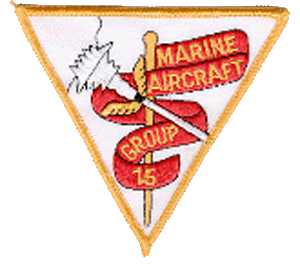
Marine Aircraft Group 15 (MAG-15) was a United States Marine Corps aviation group established during World War II. MAG-15, a transport and photo-reconnaissance training group, was commissioned on 1 March 1942, headquartered at Camp Kearny, San Diego. In addition to radio and photographic training, the Group also conducted a navigation school. Additional roles included West Coast aircraft acceptance and transport service for the Marine Corps.

Marine Fighter Attack Squadron 533 (VMFA-533) is a United States Marine Corps F-35B squadron. Also known as the "Hawks", the squadron is based at Marine Corps Air Station Beaufort, South Carolina and falls under the command of Marine Aircraft Group 31 (MAG-31) and the 2nd Marine Aircraft Wing.

Marine Night Fighter Squadron 544 was a night fighter squadron of the United States Marine Corps that was commissioned during World War II. The squadron flew the F6F-5N Hellcat and although it trained for over a year it never made it into combat. The squadron was decommissioned 20 April 1946. To date, no other Marine Corps squadron has carried the lineage and honors of VMF(N)-544.
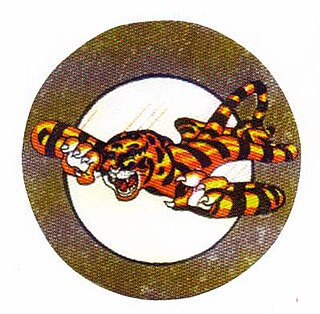
Marine Fighter Squadron 911 (VMF-911) was an aircraft squadron of the United States Marine Corps during World War II. Known as the "Devilcats", it served as a training squadron during the war, and was decommissioned in early 1946.

Marine Corps Air Station Eagle Mountain Lake was a United States Marine Corps air station that was located 23 miles (37 km) northwest of Fort Worth, Texas during World War II. Commissioned on 1 December 1942, the air station was originally supposed to be the home of the Marine Corps glider program. When the program was cancelled in 1943 the station became home to the newly created Marine Night Fighting Squadrons. After the war the air station went into caretaker status in December 1946 and became an Outlying Landing Field of Naval Air Station Dallas. After the war, it was used by various branches of the military before being sold to a private owner in the 1970s. Today, the airfield is a private airport run by the Kenneth Copeland Ministry as Kenneth Copeland Airport.
Marine Aircraft Group 93 (MAG-93) was a United States Marine Corps aviation group established during World War II. MAG-93, a dive bombing training group, was commissioned on 1 April 1944 and was initially headquartered at Marine Corps Auxiliary Airfield Bogue, North Carolina. Their mission was to train pilots to fly the Curtiss SB2C Helldiver. The group was decommissioned in October 1945 as part of the post-war drawdown of forces and has been inactive since.
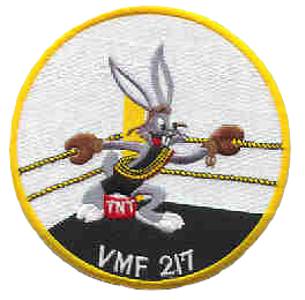
Marine Attack Squadron 217 (VMA-217) was a fighter squadron of the United States Marine Corps that was activated and fought during World War II. Known as "Max’s Wild Hares", they fought in many areas of the Pacific War including the Battle of Iwo Jima. Following the surrender of Japan, the squadron was deactivated on 10 March 1946. They were briefly reactivated as part of the Reserves but were again deactivated in 1964 and remain in an inactive status today.
Marine Fighting Squadron 413 (VMF-413) was a fighter squadron of the Marine Forces Reserve during the Cold War. It descended from bombing squadron VMB-413, which was the Marine Corps' first medium bomber squadron and had fought during World War II. Best known as "Night Hecklers" and the "Shamrocks", the squadron fought in many areas of the Pacific War.

Marine Fighting Squadron 511 (VMF-511) was a fighter squadron of the Marine Corps and Marine Forces Reserve during World War II and the Cold War which flew aircraft types such as the F6F Hellcat, F4U Corsair, and the F-8 Crusader. They were originally activated during World War II and fought during the Battle of Okinawa and the Battle of Balikpapan (1945). They specialized in close air support and during the course of the war were credited with only one plane shot down.

Marine Scout Bombing Squadron 342 (VMSB-342) was a dive bomber squadron in the United States Marine Corps. The squadron, also known as the “Bats from Hell”, was active during World War II but never saw combat in the Pacific Theater. The squadron were decommissioned on October 10, 1944.
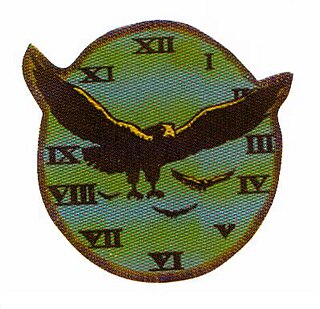
Marine Attack Squadron 543 (VMA-543) was an aviation unit of the United States Marine Corps. The squadron, also known as the "Night Hawks", were part of the Marine Forces Reserve and were based at Naval Air Station Glenview, Illinois until their deactivation on 1 April 1974. Originally activated during World War II, they fought in the Battle of Okinawa as part of the Tactical Air Force. The squadron was credited with downing 15 Japanese aircraft during the war. Following the surrender of Japan, the squadron was deactivated only to be later reactivated as part of the Reserves. They were again deactivated in 1974 and remain in an inactive status today.

Marine Fighter Squadron 541 (VMF-541) was a reserve fighter squadron of the United States Marine Corps. Originally commissioned during World War II as a night fighter unit flying the F6F-5N Hellcat, the squadron participated in combat action over Peleliu and while supporting the liberation of the Philippines in 1944–45. During the war, VMF(N)-541 was credited with downing 23 Japanese aircraft. Following the war, the squadron participated in the occupation of Northern China until returning to the States to be decommissioned on 20 April 1946. The squadron was reactivated sometime after the war in the Marine Corps Reserve until being decommissioned again in the early 1960s.
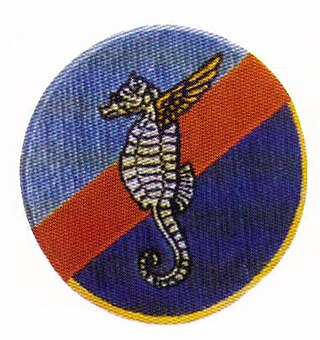
Marine Fighting Squadron 472 (VMF-472) was a fighter squadron of the United States Marine Corps during World War II. Known as "The Flying Seahorses", the squadron flew the Grumman F6F Hellcat during its short time in existence. The squadron was slated to support the invasion of Japan in late 1945 however the Japanese surrender meant it did not get further than Hawaii and did not participate in combat action during the war. VMF-472 was decommissioned on 24 December 1945 and no other Marine Corps squadron has carried its lineage and honors since.

Marine Photographic Squadron 254 (VMP-254) was a United States Marine Corps photographic reconnaissance squadron that was originally commissioned during World War II as a replacement training unit. In 1944 the squadron transitioned to the Fleet Marine Force and eventually deployed overseas in August 1945. During the war, the squadron flew the F6F-3P Hellcat and later transitioned to the Grumman F7F Tigercat. VMP-254 was decommissioned on November 30, 1949. Since that date, no other Marine Corps squadron has carried the lineage and honors of VMP-254.

Marine Night Fighter Squadron 532 was a United States Marine Corps night fighter squadron that was commissioned during World War II. The squadron, which flew the F4U-2 Corsair, was the second night fighter squadron commissioned by the Marine Corps, the first to fly a single-seat, radar-equipped night fighter, and the only Marine squadron to fly the F4U-2 in combat. VMF(N)-532 saw extensive combat operations throughout 1944 in support of Marine Corps operations at Kwajalein Atoll and the Mariana Islands. The squadron was decommissioned on 31 May 1947, as part of the post-war draw down of the service. Since then, no other Marine Corps squadron has carried the lineage and honors of VMF(N)-532.
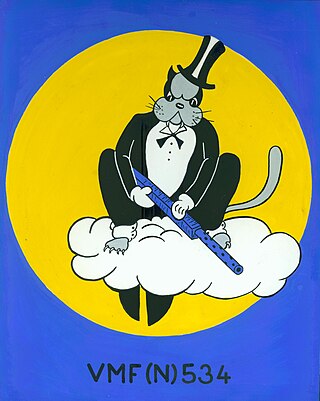
Marine Night Fighter Squadron 534 was a United States Marine Corps night fighter squadron that was commissioned during World War II. It was the fourth night fighter squadron commissioned in the service and participated in limited combat operations throughout 1944 and 1945 during Marine Corps operations over Kwajalein Atoll and the Mariana Islands. The squadron was decommissioned on 31 May 1947, as part of the post-war draw down of the service. Since then, no other Marine Corps squadron has carried the lineage and honors of VMF(N)-534.

















